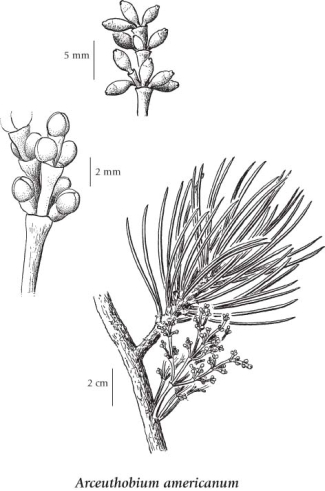American dwarf mistletoe
Santalaceae (Christmas Mistletoe family)
(Previously in Viscaceae)
Introduction to Vascular Plants
Species Information
General:
Perennial parasitic shrub; stems yellow-green, smooth, usually tufted, 2-18 cm long; segments usually 1-2 mm thick; accessory branches usually several per node, whorled, in more than 1 plane.
Flowers:
Male flowers 2-3 mm wide, borne on short lateral stems, usually 2-several per node, the buds egg-shaped, the perianth lobes rounded on the backs; female flowers 2-several, whorled at each node, short-stalked.
Fruits:
Berries, egg-shaped, about 3 mm long, greenish to bluish, usually 1-seeded, mucilaginous, maturing the 2nd summer.
Illustration

If more than one illustration is available for a species (e.g., separate illustrations were provided for two subspecies) then links to the separate images will be provided below. Note that individual subspecies or varietal illustrations are not always available.
Illustration Source: The Illustrated Flora of British Columbia
Ecology
The table below shows the species-specific information calculated from
original data (BEC database) provided by the BC Ministry of Forests and Range.
(Updated August, 2013)
| Site Information |
Value / Class |
||
|
Avg |
Min |
Max |
|
| Elevation
(metres) |
1336 | 1080 | 1543 |
| Slope
Gradient (%) |
9 | 3 | 15 |
|
Aspect (degrees) |
117 | 10 | 180 |
| Soil
Moisture Regime (SMR) [0 - very xeric; 4 - mesic; 8 - hydric] |
3 | 2 | 4 |
| Modal
Nutrient Regime
Class |
B | ||
| #
of field plots species was recorded in: |
5 | ||
| Modal
BEC Zone Class |
MS | ||
|
All BEC Zones (# of stations/zone) species was recorded in |
ESSF(1), IDF(1), MS(2) | ||
|
Source:
Klinkenberg 2013
|
|||
Habitat and Range
Parasitic on Pinus in the lowland, steppe and montane zones; infrequent in S BC, rare W of Coast-Cascade Mountains; E to MB and S to CO, UT, NV and CA.Status Information
Taxonomic Keys
1. Flowers unstalked or the female ones with stalks up to 1 mm long, usually in pairs at each node; stems over over 2 mm thick and at least 3 cm long; plants parasitic on many genera of Pinaceae.................Arceuthobium campylopodium
1. Flowers terminal on short lateral branches, the branches bearing the male flowers often more than 2 per node; stems scarcely as much as 2 mm thick and usually less than 3 cm long; plants parasitic on Pinus or Pseudotsuga. 2. Secondary branches of twigs lying in the same plane, thus flat and fanlike; stems scarcely 1 mm thick; plants parasitic on Pseudotsuga......................Arceuthobium douglasii 2. Secondary branches of twigs distinctly whorled, not fanlike; stems over 1 mm thick; plants parasitic on Pinus...............................Arceuthobium americanum |